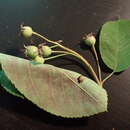pt-BR
nomes no trilho de navegação


Ampelomyces quisqualis is an anamorphic fungus that is a hyperparasite of powdery mildews. This parasitism reduces growth and may eventually kill the mildew. These mycoparasites can live up to 21 days on mildew-free host plant surfaces, attacking powdery mildew structures as soon as they appear.[4] A. quisqualis is used as the active ingredient in a commercial fungicide.[5][6]
Ampelomyces quisqualis has been shown to attack more than 64 species of powdery mildew in the genera Brasiliomyces, Erysiphe, Leveillula, Microsphaera, Phyllactinia, Podosphaera, Sphaerotheca, and Uncinula.[7] Powdery mildews in the order Erysiphales are widespread and varied. These powdery mildews occur in many countries around the world and have been recorded on 256 species of plant in 59 families.
Ampelomyces quisqualis is a mycoparasite of powdery mildews. It overwinters or survives in the absence of a suitable host as pycnidia. Raindrops cause conidia to be expelled from ripe pycnidia and these may splash onto nearby powdery mildew. Infection is favoured by humid conditions and temperatures in the range 20 to 30 °C (68 to 86 °F) and may occur within 24 hours. Hyphae, conidiophores and immature cleistothecia can all be infected, the mycoparasite entering through the cell walls, and the previously transparent tissues turning milky-white. The infection spreads through the mildew colony for seven to ten days, after which time pycnidia begin to form. Their formation is complete in two to four days, when infected cells die, swelling considerably and turning brownish. Raindrops cause the release of conidia from the mature pycnidia which can cause secondary infections. There may be several generations of the mycoparasite during the growing season.[7]
Ampelomyces quisqualis is up to 98% effective in controlling the powdery mildew Erysiphe cichoracearum on both young and old leaves of cucumber.[8] It is used to control Podosphaera fuliginea on cucumber, another common cause of powdery mildew, but at the same time causes beige angular lesions on leaves and sunken greenish or tan lesions on fruit which reduces the value of the crop.[9]
The conidia of Ampelomyces quisqualis have been formulated and marketed in pellet and powder form as "AQ10". In the laboratory these were only partially efficient; they did not reduce the size of colonies of the powdery mildew Podosphaera fuliginea to any significant extent, but reduced the number of new infections initiated.[10] However, acceptable disease control has been achieved in various greenhouse and field-grown crops. It is usually necessary to repeat the applications, and high humidity and raindrops assist in spreading the mycoparasite to new mildew colonies.[7]
{{cite web}}: CS1 maint: archived copy as title (link) {{cite journal}}: CS1 maint: multiple names: authors list (link) {{cite journal}}: CS1 maint: multiple names: authors list (link) {{cite journal}}: CS1 maint: multiple names: authors list (link) Ampelomyces quisqualis is an anamorphic fungus that is a hyperparasite of powdery mildews. This parasitism reduces growth and may eventually kill the mildew. These mycoparasites can live up to 21 days on mildew-free host plant surfaces, attacking powdery mildew structures as soon as they appear. A. quisqualis is used as the active ingredient in a commercial fungicide.
Ampelomyces quisqualis est une espèce de champignons ascomycètes de la famille des Phaeosphaeriaceae.
Cette espèce de champignon est un mycoparasite hyperparasite dont les hôtes sont des champignons, dont de nombreuses espèces de l'ordre des Erysiphales qui sont les agents pathogènes de diverses formes d'oïdium. Elle a fait l'objet de nombreuses études depuis 50 ans en vue de son utilisation en lutte biologique[2].
Selon Catalogue of Life (10 octobre 2014)[1] :
Ampelomyces quisqualis est une espèce de champignons ascomycètes de la famille des Phaeosphaeriaceae.
Cette espèce de champignon est un mycoparasite hyperparasite dont les hôtes sont des champignons, dont de nombreuses espèces de l'ordre des Erysiphales qui sont les agents pathogènes de diverses formes d'oïdium. Elle a fait l'objet de nombreuses études depuis 50 ans en vue de son utilisation en lutte biologique.
Ampelomyces quisqualis is een natuurlijk voorkomende schimmel. Het is een hyperparasiet van echte meeldauw en wordt gebruikt voor de biologische bestrijding daarvan op druiventeelten. Het infecteert en vormt pycnidiën in de schimmeldraden en conidiën van schimmels uit de familie Erysiphaceae. Dit remt de groei en kan leiden tot het afsterven van de meeldauwkolonie.
De naam Ampelomyces quisqualis werd gegeven door Vincenzo de Cesati in 1852. Anton de Bary noemde de schimmel Cicinnobolus cesatii in 1870. Chester W. Emmons beschreef uitgebreid het antagonisme van de schimmel ten opzichte van echte meeldauw in 1930.[1]
Ampelomyces quisqualis is in de Europese Unie toegelaten als schimmelbestrijdingsmiddel sedert 1 april 2005.[2] Het commercieel verkrijgbaar product, AQ10 bevat de stam A. quisqualis AQ10, die wordt bekomen door fermentatie in vloeibaar midden.[3] AQ10 wordt verkocht door Intrachem (oorspronkelijk door Ecogen Inc.).[4]
Ampelomyces quisqualis is een natuurlijk voorkomende schimmel. Het is een hyperparasiet van echte meeldauw en wordt gebruikt voor de biologische bestrijding daarvan op druiventeelten. Het infecteert en vormt pycnidiën in de schimmeldraden en conidiën van schimmels uit de familie Erysiphaceae. Dit remt de groei en kan leiden tot het afsterven van de meeldauwkolonie.
De naam Ampelomyces quisqualis werd gegeven door Vincenzo de Cesati in 1852. Anton de Bary noemde de schimmel Cicinnobolus cesatii in 1870. Chester W. Emmons beschreef uitgebreid het antagonisme van de schimmel ten opzichte van echte meeldauw in 1930.
Ampelomyces quisqualis is in de Europese Unie toegelaten als schimmelbestrijdingsmiddel sedert 1 april 2005. Het commercieel verkrijgbaar product, AQ10 bevat de stam A. quisqualis AQ10, die wordt bekomen door fermentatie in vloeibaar midden. AQ10 wordt verkocht door Intrachem (oorspronkelijk door Ecogen Inc.).
Ampelomyces quisqualis je grzib[2], co go ôpisoł Ces. 1852. Ampelomyces quisqualis nŏleży do zorty Ampelomyces i familije Phaeosphaeriaceae.[3][4] Żŏdne podgatōnki niy sōm wymianowane we Catalogue of Life.[3]
Ampelomyces quisqualis je grzib, co go ôpisoł Ces. 1852. Ampelomyces quisqualis nŏleży do zorty Ampelomyces i familije Phaeosphaeriaceae. Żŏdne podgatōnki niy sōm wymianowane we Catalogue of Life.